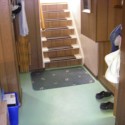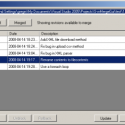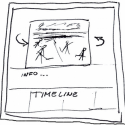
With the basement torn out, and access to all of the main floor, I started running wiring for network and video. I’m running two network cables and one cable to each of the bedrooms, two spots in the family room, and one spot in the dining room.
Since the upstairs is finished, I wanted to disrupt it the least amount possible, so I purchased a 54″ flexible installer’s drill bit. It’s 9⁄16″ which is big enough for all the cables I’m running.

My girlfriend and I just bought a house. It’s a bit older – 32 years old, to be exact – and it shows, in a few places. My first big project is to renovate the basement and turn it into an office / rec-room area, and a laundry room. I figured it would be interesting to some people if I blogged, plus it is some extra motivation for me to get it done in a timely basis.

I just created a Google Code project for a quick and dirty little app I built, SvnMergeGui. As you may suspect, it’s a GUI to SvnMerge.
It uses ClickOnce for the installation (because it was really easy to do from VisualStudio), and is pointed at the svn repository for updates – so although I’ve never tried it, the theory is that it will have automatic updates built-in. You can download the install files from the project page linked above.

Often when I am writing software I design the user interface first, or at least separately, from the rest of the code. Jeff Atwood describes UI First software development on his blog:
Of course, UI is hard, far harder than coding for developers. It’s tempting to skip the tough part and do what comes naturally — start banging away in a code window with no real thought given to how the user will interact with the features you’re building.
I’ve talked to a few of my friends about the stupidity of the non-contact credit cards (that use RFID) before, but at the time I couldn’t find any practical examples showing that it was actually possible to steal credit card information just by walking past people. Well, now you can watch it in action:
Via BoingBoing
So it’s been a while – almost a year! – since I updated this site, which probably also means no one pays attention anymore, but oh well. I just thought I’d make a little post about a new service I’ve been using over the last couple of days called Jango. It’s basically personalized radio stations, along the lines of Pandora, but it’s a bit more social, and (the biggest thing for me) it works in Canada.
Well finally wireless number portability is coming to Canada on March 14th. This means you will be able to transfer your wireless number to wireless another carrier, to a landline, or your landline to a wireless carrier. Transfers between wireless carriers should take 2.5 hours, transfers between wireless and landline could take up to two days, and fees for doing a transfer are left up to individual providers. I haven’t yet found out if transfers from wireless or landline to VoIP carriers will be possible, although I don’t see why it wouldn’t be.
I felt compelled to respond to an article NetworkWorld published (which made Slashdot) that talks about how VoIP and security systems are incompatible (as in home or business burglar alarms), and is apparently based on an article published by CBC. It does raise some valid points, but mostly it is sensational garbage.
First off, as the article correctly points out, VoIP does require power, so if you lose power, then you lose your phone line.
I’ve posted my php sendmail wrapper before, but I just noticed that Ilia Alshanetsky has written a php mail logging patch that essentially does the same thing, but from within PHP itself. This is nice because it can log the full path of the file and line where mail() was called, whereas my script can only log as much info as PHP passes to sendmail (which isn’t very much) and what it can get from the environment.
I haven’t posted here in a while, so I just thought I’d mention something about freePBX 2.2.0, which was just released a couple days ago. For those that don’t know, freePBX is an open source configuration and web-based interface to Asterisk, which allows you to configure and run a PBX that has the equivalent functionality to commercial PBXs costing several thousands of dollars (or more). I’ve been involved with the freePBX project since December 2004 (when it was called AMPortal, or AMP for short), and minus a 6 month hiatus in early 2006, I have been contributing to the project ever since.
 With the basement torn out, and access to all of the main floor, I started running wiring for network and video. I’m running two network cables and one cable to each of the bedrooms, two spots in the family room, and one spot in the dining room.
Since the upstairs is finished, I wanted to disrupt it the least amount possible, so I purchased a 54″ flexible installer’s drill bit. It’s 9⁄16″ which is big enough for all the cables I’m running.
With the basement torn out, and access to all of the main floor, I started running wiring for network and video. I’m running two network cables and one cable to each of the bedrooms, two spots in the family room, and one spot in the dining room.
Since the upstairs is finished, I wanted to disrupt it the least amount possible, so I purchased a 54″ flexible installer’s drill bit. It’s 9⁄16″ which is big enough for all the cables I’m running. My girlfriend and I just bought a house. It’s a bit older – 32 years old, to be exact – and it shows, in a few places. My first big project is to renovate the basement and turn it into an office / rec-room area, and a laundry room. I figured it would be interesting to some people if I blogged, plus it is some extra motivation for me to get it done in a timely basis.
My girlfriend and I just bought a house. It’s a bit older – 32 years old, to be exact – and it shows, in a few places. My first big project is to renovate the basement and turn it into an office / rec-room area, and a laundry room. I figured it would be interesting to some people if I blogged, plus it is some extra motivation for me to get it done in a timely basis. I just created a Google Code project for a quick and dirty little app I built, SvnMergeGui. As you may suspect, it’s a GUI to SvnMerge.
It uses ClickOnce for the installation (because it was really easy to do from VisualStudio), and is pointed at the svn repository for updates – so although I’ve never tried it, the theory is that it will have automatic updates built-in. You can download the install files from the project page linked above.
I just created a Google Code project for a quick and dirty little app I built, SvnMergeGui. As you may suspect, it’s a GUI to SvnMerge.
It uses ClickOnce for the installation (because it was really easy to do from VisualStudio), and is pointed at the svn repository for updates – so although I’ve never tried it, the theory is that it will have automatic updates built-in. You can download the install files from the project page linked above. Often when I am writing software I design the user interface first, or at least separately, from the rest of the code. Jeff Atwood describes UI First software development on his blog:
Of course, UI is hard, far harder than coding for developers. It’s tempting to skip the tough part and do what comes naturally — start banging away in a code window with no real thought given to how the user will interact with the features you’re building.
Often when I am writing software I design the user interface first, or at least separately, from the rest of the code. Jeff Atwood describes UI First software development on his blog:
Of course, UI is hard, far harder than coding for developers. It’s tempting to skip the tough part and do what comes naturally — start banging away in a code window with no real thought given to how the user will interact with the features you’re building.